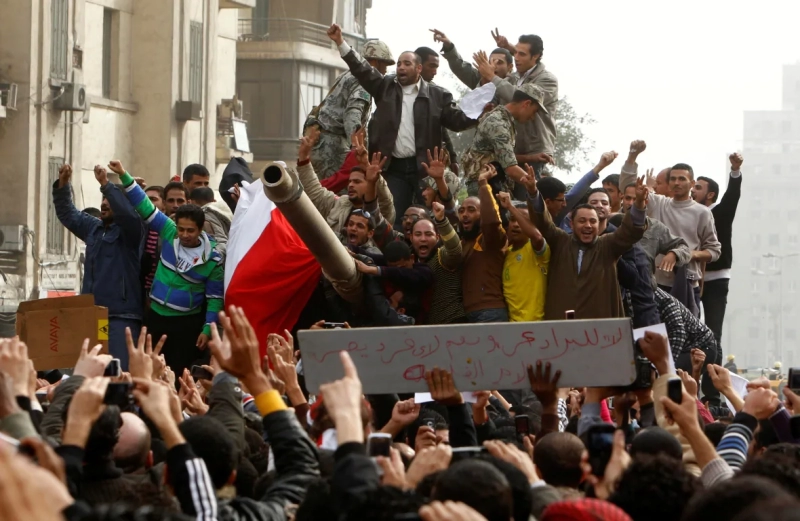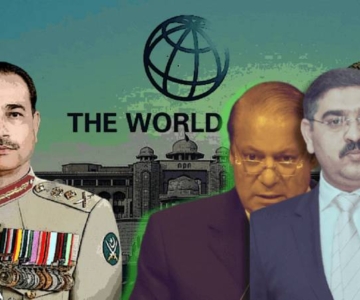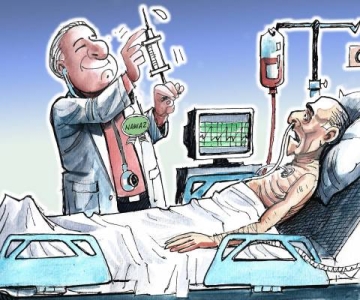February 2011 saw the iron fist of Hosni Mubarak being wrenched open after three decades of repressive rule. During this period, the Egyptian secret service – the Mukhabarat – and the country’s powerful military appeared to have imposed an unbreakable hold on Egyptian society and the polity. However, the revolution at Tahrir Square, in central Cairo, took not only the indigenous power elite by surprise, but also astounded its backers abroad – particularly the US and Israel, for which a pliable Mubarak-led regime had long been a key ally. Yet suddenly tens of thousands of young Egyptians were coming together, unified not only by a repudiation of religious differences between Christians and Muslims but also an allegiance to non-violence, pervasive disgust at corruption, and the country’s decades-long lack of democracy. Helping them to organise were modern social-networking tools, which had been used to great effect the previous month in neighbouring Tunisia as well.
Protests in Egypt have laid bare the political manipulations that maintain theocracies such as those in Saudi Arabia and Iran under the guise of religious sanction. Egyptians – and, by their example, the rest of what is often called the ‘Muslim world’ – have learned that they can oppose leaders without denouncing religion. The domino effect that has been seen in subsequent protests in Libya, Bahrain, Jordan and elsewhere threatens – or promises – to alter the political landscape of West Asia.
It has been said before that ripples from West Asia have the energy to reach both Kashmir and New Delhi, and comparisons of Tahrir Square with Lal Chowk in Srinagar have recently aroused the interest of Kashmiris at home and abroad. Nonetheless, it remains to be seen whether a meaningful analogy can truly be drawn. Kashmir has been turned into a cantonment by the Indian state, with an abnormally high ratio of security personnel to citizens. Unlike the conscription-based army of Egypt, which took tangible steps to establish its neutrality during the people’s movement in Cairo, the Indian security forces have continued with their trigger-happy ways. Further, the violence against the state of the 1990s has been replaced by quasi-institutionalised, pseudo-democratic platforms for allowing Kashmiris to temporarily blow off steam.
It would be unjust to castigate the traumatised youth of Kashmir for not adhering to principles of non-violence (the use of stones, mostly), when the human rights of Kashmiris are routinely violated. Perceived only as tactical pawns in the larger battle for dominance in the region, Kashmiris have suffered in the battle for ascendancy between Pakistan – the self-proclaimed champion of Kashmiri rights – and India, which is seen as having ‘occupied’ this territory for over sixty years. If India is to be blamed for killing militants, the ‘heroes’ of the Kashmiri cause, then Pakistan must take responsibility for having signed their death warrants. Administrators in the form of Omar Abdullah and extremists in the image of Syed Ali Shah Geelani and Masrat Alam have done little to advance the cause of the Kashmiri population.
Today, if nothing else, the developments in the Arab world should be an eye-opener for both New Delhi and Islamabad. Taking inspiration from the years of bottled-up frustration in West Asia, urgent steps clearly need to be taken to provide the people of Kashmir – all of Kashmir – with true representation.
Pakistan’s Mubarak?
Though there has also been talk of a ‘revolution’ in Pakistan, palpable differences exist between Egypt and Pakistan, and the facile comparisons being made by some Western commentators bear little resemblance to reality. For example, in mid-February, Declan Walsh of The Guardian suggested that conditions are now ripe for a mass revolt in Pakistan. He preposterously compared Hosni Mubarak to Aijaz Haroon, the managing director of Pakistan International Airlines (PIA), who has been asked to resign in light of recent strikes by PIA workers. (Indeed, Walsh’s dissatisfaction with the status quo seems to stem from him being stranded in Quetta due to flight delays.) He went on to say that the mood in Pakistan might resemble that in Iran in 1979, when the Iranian people rid themselves of the US-backed Shah – and opened the door to theocratic Islamic rule.
We need to examine the situation in Pakistan far more critically. With Asif Ali Zardari’s government, there is no real ‘dictator’ to overthrow. Four years ago, protests against then-President Pervez Musharraf pitted rival groups against each other, triggering counter-productive antagonism throughout society. Further, Musharraf – in this analogy, Pakistan’s Mubarak – has already departed the political scene and the country. Mubarak, of course, had been in power for three decades. President Zardari is no Hosni Mubarak. As several commentators have pointed out, President Zardari’s weakness is as emblematic of his leadership as the Egyptian dictator’s strength was of his. Meanwhile, the comparisons being made by the Nepali commentators seem to be equally out of whack – it is not as if the people of Nepal are hoping for an outburst, as they had theirs with the People’s Movement of 2006.
Even without an actual dictator against which to arrange protests, there is widespread agreement that the military is in charge in Pakistan. A true revolution would then see the army, in some way, being put out of commission – or going over to the side of the protestors, as ultimately swayed the result in Egypt. But how can a revolt against the army take place when it is not even officially in charge? The economy continues to be a problem, with rocketing inflation, a crashing currency and capital flight very much on the cards. But can this, as some seem to believe, really lead to widespread unrest in the streets? Russia might have had bread riots against the tsarist government in 1917, but we can hardly use such examples to theorise that economic disparity will result in an overthrow of the ruling class.
What does link the revolution in Egypt with the potential for one in Pakistan is the huge proportion of the young, most of whom are discontented with the current state of affairs in the country. A British Council report published in 2009 (which defines the ‘youth’ as those between 18 and 29), suggested that only one in ten Pakistani youths have confidence in the current government set-up. Half of this population reported facing unemployment, with four-fifths asserting that the country is not headed in the right direction. Indisputably, it was the power of the youth in Egypt that formed the driving force of Tahrir Square. If the disillusionment of this segment is taken as a benchmark, then a revolution in Pakistan could indeed appear closer than otherwise expected.
Still, the ambiguity over what can constitute the basis for a broad-based movement of the Pakistani people is symptomatic of Pakistan’s varied troubles today. While there are mass protests under religious banners to halt changes in the blasphemy law, city liberals quote Gandhi, King and Thoreau – all heathens in the eyes of the street mullah – and hope that if there is a revolution to come, it would be a people’s revolution, not an Islamist one. Clearly, there is no basis for a national mass movement yet, and there is too much that divides the country and too little that brings its many peoples together. The best that Pakistan can do in the current context – and the message its people can take from the recent experiences in West Asia – is to know that change is possible, and that this change has the potential to be one that is peaceful, where one can stand up to the religious right wingers without being anti-Islam.




